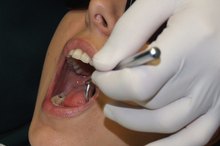Jaw Cancer Symptoms
Cancer that arises in the jawbones is termed primary jaw cancer. Examples of primary jaw cancer include malignant giant cell tumors, Ewing sarcoma and osteosarcoma 3. Alternatively, cancers arising from other tissues can spread to the jaw. This is secondary jaw cancer. Jawbone invasion due to squamous cell carcinoma of the mouth is a frequent example. The symptoms of primary and secondary jaw cancer reflect local bone destruction caused by uncontrolled tumor growth. Recognition of jaw cancer symptoms can aid in early diagnosis and treatment.
If you are experiencing serious medical symptoms, seek emergency treatment immediately.
Jaw Pain and Tenderness
Jaw pain is a characteristic symptom of jaw tumors. The pain characteristically becomes persistent and may progress slowly, increasing in intensity as the tumor grows. Jaw pain may radiate to the neck or elsewhere in the face if the tumor is near a facial nerve. Depending on the location of the tumor within the jaw, chewing may trigger increased pain. The area affected by the tumor usually feels tender to the touch.
- Jaw pain is a characteristic symptom of jaw tumors.
- Depending on the location of the tumor within the jaw, chewing may trigger increased pain.
Facial or Intraoral Mass
Early Signs of Squamous Cell Mouth Cancer
Learn More
Jaw cancer tumors of significant size may cause a noticeable mass on the face or within the mouth. Cancers arising on the inner area of the jawbone can cause masses within the mouth. Those arising on the outside of the jawbone typically lead to facial masses. Ewing sarcoma of the jaw typically affects adolescents and young adults. These cancers grow rapidly because of the limited bone mass of the jaw compared to the long bones of the legs or arms, where Ewing tumors more commonly occur. Notably, the National Cancer Institute reports osteosarcomas of the jaw and facial bones have a better long-term prognosis compared to those that arise in the extremities. On average, osteosarcomas of the jaw and facial bones are smaller than tumors of the long bones of the arms and legs and have a lower rate of spread to other sites in the body.
- Jaw cancer tumors of significant size may cause a noticeable mass on the face or within the mouth.
- On average, osteosarcomas of the jaw and facial bones are smaller than tumors of the long bones of the arms and legs and have a lower rate of spread to other sites in the body.
Loose Teeth
The development of loose teeth may be an early indication of a jaw tumor. The jaws contain individual sockets in which the teeth are anchored. Tumors of the jaw can erode these sockets causing loosening of the teeth. Depending on the size of the tumor, one or more teeth may be affected. Because of the potential involvement of the teeth, dentists have a role in the early detection of jaw tumors.
- The development of loose teeth may be an early indication of a jaw tumor.
- Because of the potential involvement of the teeth, dentists have a role in the early detection of jaw tumors.
Warning
Nose Cancer Signs
Learn More
See your doctor or dentist right away if you have any symptoms that may indicate the possibility of jaw cancer. While other, noncancerous conditions can cause similar symptoms, it's better to err on the side of caution.
Related Articles
References
- Merck Manual Professional Version: Jaw Tumors
- American Cancer Society: Bone Cancer
- National Cancer Institute: Osteosarcoma and Malignant Fibrous Histiocytoma of Bone Treatment (PDQ) -- Health Professional Version
- National Journal of Maxillofacial Surgery: Ewing's Sarcoma of the Mandible
- National Institute of Dental and Craniofacial Research: Detecting Oral Cancer: A Guide for Health Care Professionals
- Osteosarcoma Risk Factors. American Cancer Society
- Osteosarcoma and Malignant Fibrous Histiocytoma of Bone Treatment (PDQ®)–Health Professional Version. National Cancer Institute
- Kumar VS, Barwar N, Khan SA. Surface osteosarcomas: Diagnosis, treatment and outcome. Indian J Orthop. 2014;48(3):255-61. doi:10.4103/0019-5413.132503
- Chondrosarcoma. American Cancer Society.
- How common is Ewing sarcoma? St. Jude Children's Research Hospital
- American Cancer Society. Tests for Osteosarcoma.
- National Caner Institute. Osteosarcoma and Malignant Fibrous Histiocytoma of Bone Treatment (PDQ®)–Health Professional Version.
Writer Bio
Dr. Tina M. St. John owns and operates a health communications and consulting firm. She is also an accomplished medical writer and editor, and was formerly a senior medical officer with the U.S. Centers for Disease Control and Prevention. St. John holds an M.D. from Emory University School of Medicine.









